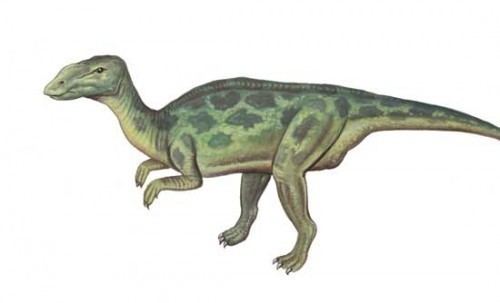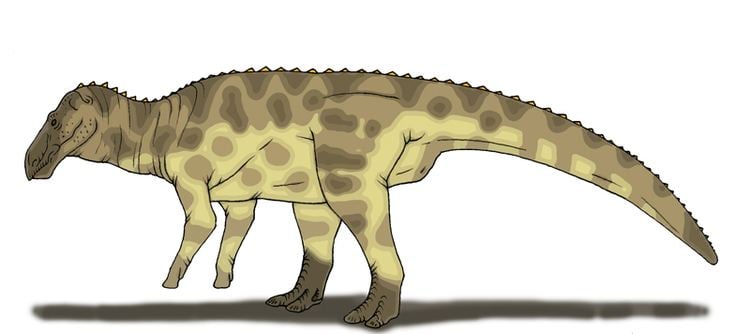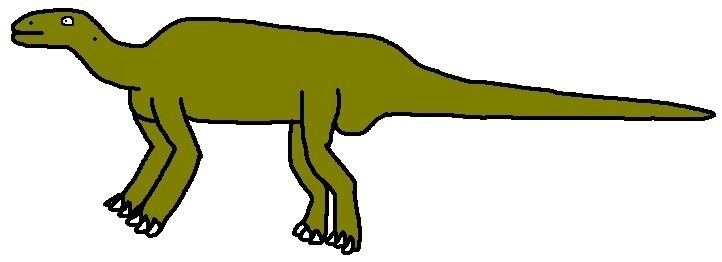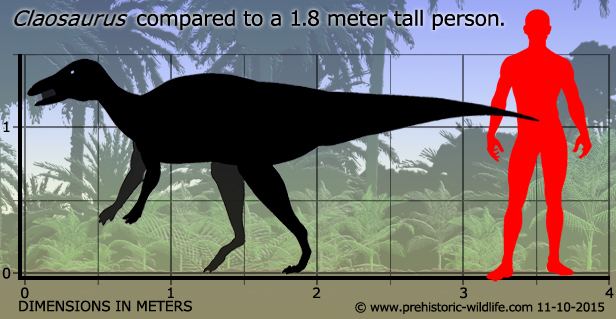Superfamily †Hadrosauroidea Rank Genus | Class Reptilia Suborder †Ornithopoda Phylum Chordata | |
 | ||
Similar Thespesius, Lophorhothon, Diclonius, Barsboldia, Cionodon | ||
Claosaurus (/ˌkleɪoʊˈsɔːrəs/ KLAY-o-SAWR-əs; Greek κλάω, klao meaning 'broken' and σαῦρος, sauros meaning 'lizard'; "broken lizard", referring to the odd position of the fossils when discovered) is a genus of primitive hadrosaurian (early duck-billed dinosaur) that lived during the Late Cretaceous Period (Campanian).
Contents

Traditionally classified as an early member of the family Hadrosauridae, a 2008 analysis found Claosaurus agilis to be outside of the clade containing Hadrosaurus and other hadrosaurids, making it the closest not-hadrosaurid relative of true hadrosaurids within the clade Hadrosauria.

Claosaurus skin and color concept hd
DescriptionEdit

Claosaurus had a slender body and slim feet, with long legs, small arms, and a long, stiff tail. It probably grew to a length of about 3.5 meters (11.5 feet) and weighed roughly 475 kg.

It appears to have walked on its hind legs, dropping to all fours only to graze. Like other hadrosaurs, it was an herbivore.
HistoryEdit
Evidence of its existence was first found near the Smoky Hill River in Kansas, United States in the form of partial skull fragments and as an articulated postcranial skeleton. Originally named Hadrosaurus agilis (Marsh, 1872), it was placed in a new genus and renamed Claosaurus agilis in 1890 when major differences between this specimen and Hadrosaurus came to light.
In 1892, Marsh named a second species, C. annectens. This species later was reassigned to Anatosaurus and then Edmontosaurus, where it is currently. G. R. Wieland named third species C. affinis in 1903, which he compared to C. annectens. C. affinis was founded on remains from the Pierre Shale of South Dakota, found in association with remains of the giant sea turtle Archelon. At some point after its description, the fragmentary remains were mixed up with the original remains of C. agilis, and a toe bone from C. agilis was accidentally thought to be the only part of the holotype remains that could be located. This was corrected by Joseph Gregory in 1948, who found three toe bones from the right foot of a large hadrosaur in the Yale collections that had comparable preservation to the Pierre Shale turtle remains and were associated with labels in Wieland's handwriting. Gregory found the toe bones to be very similar in size to the corresponding bones of Marsh's Claosaurus annectens, but did not reassign the species due to its much older age and fragmentary remains. "C. affinis" was considered a dubious hadrosaur in the 2004 review by Jack Horner and colleagues. They reported its type material as lost, although they also reported these remains as only including a single toe bone, instead of the three toe bones of Gregory.
Reports of gastroliths, or stomach stones, in Claosaurus are actually based on a probable double misidentification. First, the specimen is actually of Edmontosaurus annectens. Barnum Brown, who discovered the specimen in 1900, referred to it as Claosaurus, because E. annectens was thought to be a species of Claosaurus at the time. Additionally, it is more likely that the supposed gastroliths represent gravel washed in during burial.
